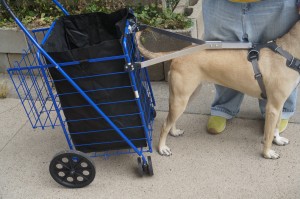Last week, the three mechanical engineer students created and trialed the 2nd prototype of the dogcart. With our client’s approval, they designed a dogcart similar to the Playmarket Go 3 Shopping Trolley Cart, a cart that she currently uses for grocery shopping and daily use. For daily use, she said that she carries a lot of books if going to/from the library, a tablet/kindle, food and drink for her and Orenda, her dog, a mat for Orenda, and items that she purchases during the day. After trialing the 2nd prototype, she said that this cart is a good size for daily use and a little small for groceries, but she said that she is willing to make extra trips if necessary. She suggested that we add attachable storage to create more room. It took approximately 1 minute to put the harness on Orenda and 20-30 seconds to attach the cart to the harness. The setup time could vary depending on the dog’s level of excitement. From our 1st prototype, we shortened the length from the cart to the harness. For the 2nd prototype, our client’s biggest concern is the tires and their potential for wear as well as their ability to transverse the necessary terrain (e.g. sidewalks and streets). It is a top priority for our client that the cart is all-terrain. Because changing tires will be necessary after long-term use, the next prototype should consider simplifying wheel replacement process so that our client is able to do this successfully and independently. We have yet to test the maneuverability of the cart when it is attached to Orenda because of her level of excitement. Since our 1st blog post, we have learned a lot about our client that may influence our design of the dogcart. We learned more in depth about the impact of her osteopetrosis, which causes her bones to become dense. She reported that her secondary diagnoses are arthritis, tendonitis, and carpal tunnel of her hands. Her conditions impact her ability to hold onto the dogcart handle and hold onto the dog leash. Thus, it is important that we add a handle that is ergonomically friendly to decrease our client’s discomfort and pain. It is also important to consider our client’s ability to independently put the harness on Orenda as well as to independently clip on/off the cart to the harness. Because her condition impacts motor functioning of her hands, it is important to observe our client attach/detach the dogcart to make sure that she can do so independently and ergonomically. Also, it is concerning that our client reports having difficulty holding onto the dog leash, especially because Orenda is in the process of getting trained. During the last meeting with our client, Orenda was very excited and couldn’t stand still. At one point, she even rotated almost completely while still attached to the cart. In addition, the next prototype should consider redesigning the clamps so that the dogcart can fold and be placed inside our client’s home to extend its lifetime. Future testing is required for maneuvering the cart on the T or bus and when it is attached to Orenda with heavier loads. We are thinking of go grocery shopping with our client and Orenda attached to the cart to further test durability and maneuverability of the dogcart.
Image of Playmarket Go 3 Shopping Trolley Cart
http://www.sierratradingpost.com/playmarket-go-3-shopping-trolley-cart~p~8486m/
Image 1 of prototype 2
Image 2 of prototype 2


